
The Cucurbitaceae, also called cucurbits or the gourd family, are a plant family consisting of about 965 species in 101 genera. Those of most agricultural, commercial or nutritional value to humans include:

Luffa is a genus of tropical and subtropical vines in the pumpkin, squash and gourd family (Cucurbitaceae).

Gourds include the fruits of some flowering plant species in the family Cucurbitaceae, particularly Cucurbita and Lagenaria. The term refers to a number of species and subspecies, many with hard shells, and some without. Many gourds have large, bulbous bodies and long necks, such as Dipper Gourds, many variations of Bottle Gourd and caveman club gourds. One of the earliest domesticated types of plants, subspecies of the bottle gourd, Lagenaria siceraria, have been discovered in archaeological sites dating from as early as 13,000 BC. Gourds have had numerous uses throughout history, including as tools, musical instruments, objects of art, film, and food.

Cucurbita is a genus of herbaceous fruits in the gourd family, Cucurbitaceae, native to the Andes and Mesoamerica. Five edible species are grown and consumed for their flesh and seeds. They are variously known as squash, pumpkin, or gourd, depending on species, variety, and local parlance. Other kinds of gourd, also called bottle-gourds, are native to Africa and belong to the genus Lagenaria, which is in the same family and subfamily as Cucurbita, but in a different tribe, their young fruits are eaten much like those of the Cucurbita species.
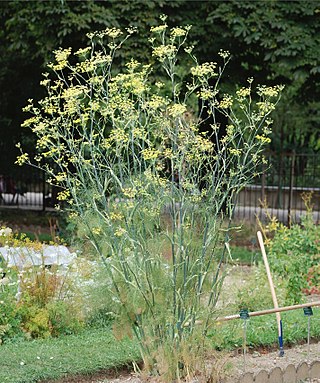
Fennel is a flowering plant species in the carrot family. It is a hardy, perennial herb with yellow flowers and feathery leaves. It is indigenous to the shores of the Mediterranean but has become widely naturalized in many parts of the world, especially on dry soils near the sea coast and on riverbanks.

Cucurbita pepo is a cultivated plant of the genus Cucurbita. It yields varieties of winter squash and pumpkin, but the most widespread varieties belong to the subspecies Cucurbita pepo subsp. pepo, called summer squash.

Momordica charantia is a tropical and subtropical vine of the family Cucurbitaceae, widely grown in Asia, Africa, and the Caribbean for its edible fruit. Its many varieties differ substantially in the shape and bitterness of the fruit.

Urtica dioica, often known as common nettle, burn nettle, stinging nettle or nettle leaf, or just a nettle or stinger, is a herbaceous perennial flowering plant in the family Urticaceae. Originally native to Europe, much of temperate Asia and western North Africa, it is now found worldwide. The species is divided into six subspecies, five of which have many hollow stinging hairs called trichomes on the leaves and stems, which act like hypodermic needles, injecting histamine and other chemicals that produce a stinging sensation upon contact.

Benincasa hispida, the wax gourd, also called ash gourd, white gourd, winter gourd, winter melon, tallow gourd, ash pumpkin, Chinese preserving melon, is a vine grown for its very large fruit, eaten as a vegetable when mature. It is the only member of the genus Benincasa.

Calabash, also known as bottle gourd, white-flowered gourd, long melon, birdhouse gourd, New Guinea bean, New Guinea butter bean, Tasmania bean, and opo squash, is a vine grown for its fruit. It can be either harvested young to be consumed as a vegetable, or harvested mature to be dried and used as a utensil, container, or a musical instrument. When it is fresh, the fruit has a light green smooth skin and white flesh.

Coccinia grandis, the ivy gourd, also known as scarlet gourd, is a tropical vine. It grows primarily in tropical climates and is commonly found in the Indian states where it forms a part of the local cuisine. Coccinia grandis is cooked as a vegetable dish.
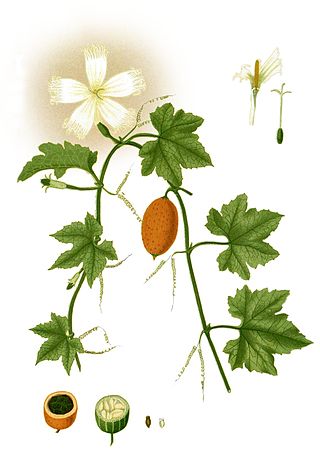
Trichosanthes is a genus of tropical and subtropical vines. They belong to the cucumber family (Cucurbitaceae), and are closely related to Gymnopetalum. Hodgsonia, formerly included here, is usually considered a well-distinct genus nowadays.

Trichosanthes dioica, also known as pointed gourd, is a tropical perennial cucurbit plant with its origin in the Indian subcontinent. The plant propagated vegetatively and grows with training on a support system as pencil-thick vines (creepers) with dark-green cordate (heart-shaped) simple leaves. It is a well-developed dioecious plants having distinct male and female flowers on staminate and pistillate plants, respectively. The fruits are green with white or no stripes' and have unpalatable seeds. Size can vary from small and round to thick and long — 2 to 6 inches. It thrives well under a hot to moderately warm and humid climate. The plant remains dormant during the winter season and prefers fertile, well-drained sandy loam soil due to its susceptibility to water-logging.

Trichosanthes cucumerina is a tropical or subtropical vine. Its variety T. cucumerina var. anguina raised for its strikingly long fruit. In Asia, it is eaten immature as a vegetable much like the summer squash and in Africa, the reddish pulp of mature snake gourd is used as an economical substitute for tomato. Common names for the cultivated variety include snake gourd, serpent gourd, chichindapadwal and Snake Tomato.

Momordica balsamina is a tendril-bearing annual vine native to the tropical regions of Africa, introduced and invasive in Asia, Australia, Central America, and North America, where they have been found in some parts of Florida. In 1810, Thomas Jefferson planted this vine in his flower borders at Monticello along with larkspur, poppies, and nutmeg.
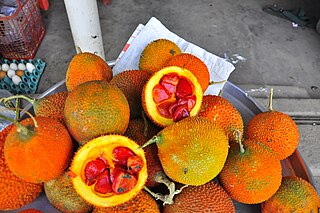
Gac, from the Vietnamese gấc, scientific name Momordica cochinchinensis, is a species of plant in the melon and cucumber family Cucurbitaceae which is native to countries throughout Southeast Asia and to Queensland, Australia. It is notable for its vivid orange-reddish color resulting from a mix of beta-carotene and lycopene.
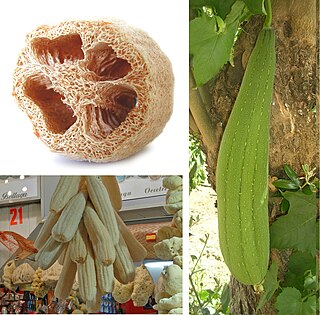
Luffa aegyptiaca, the sponge gourd, Egyptian cucumber or Vietnamese luffa, is an annual species of vine cultivated for its fruit, native to South and Southeast Asia.

Luffa acutangula is a cucurbitaceous vine that is commercially grown for its unripe fruits as a vegetable. Mature fruits are used as natural cleaning sponges. Its fruit slightly resembles a cucumber or zucchini with ridges. It is native to South Asia and has been naturalised in other regions. It is also grown as a houseplant in places with colder climates. English common names include angled luffa, Chinese okra, dish cloth gourd, ridged gourd, sponge gourd, vegetable gourd, strainer vine, ribbed loofah, silky gourd, silk gourd,

Watermelon is a flowering plant species of the Cucurbitaceae family and the name of its edible fruit. A scrambling and trailing vine-like plant, it is a highly cultivated fruit worldwide, with more than 1,000 varieties.
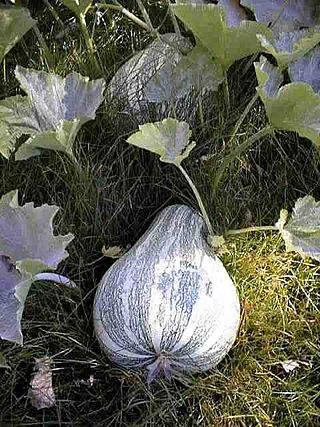
Cucurbita argyrosperma, also called the cushaw squash and silver-seed gourd, is a species of winter squash originally from the south of Mexico. This annual herbaceous plant is cultivated in the Americas for its nutritional value: its flowers, shoots, and fruits are all harvested, but it is cultivated most of all for its seeds, which are used for sauces. It was formerly known as Cucurbita mixta.
























